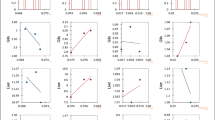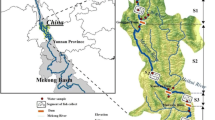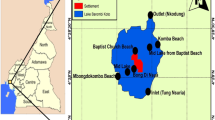Abstract
Heavy metal bioaccumulation in organisms is primarily a result of dietary uptake. The current study examines the concentrations of heavy metals (Pb, Cd, Cr, and Cu) in fish feed, water, sediment, and three fish species (Catla catla, Labeo rohita, and Cyprinus carpio) from different feeding zones in a polyculture pond system. Furthermore, associated human health risks were also evaluated. The fish samples (n = 25 for each species) were collected from 10 different fish ponds in the Kohat district, Pakistan. Heavy metals were determined using an atomic absorption spectrometer. Results revealed higher concentrations of heavy metals in sediment, followed by water. However, the concentration of heavy metals in fish feed was lower than the standard limits. In the case of fish, the bottom feeder (C. carpio) notably exhibited higher (P < 0.05) levels of heavy metals than the column feeder (L. rohita) and surface feeder (C. catla) fish. Moreover, in the liver of all fish species, the bioaccumulation of heavy metals was higher, followed by the gills. Principal component analysis (PCA) demonstrated a strong correlation of heavy metals in C. carpio gills, flesh, feed, and pond water, while the heavy metals in the liver correlated with the detected metals in sediment. The human health risk analysis shows that bottom feeder fish had higher estimated daily intake (EDI), target hazard quotient (THQ), and hazard index (HI) values (> 1). Consequently, the exposed population may experience adverse health effects. The findings of this study suggest that the bottom feeder (C. carpio) bioaccumulates a higher concentration of heavy metals than column (L. rohita) and surface feeder (C. catla) in the polyculture system.










Similar content being viewed by others
Data Availability
The datasets generated during and/or analyzed during the current study are available from the corresponding author upon reasonable request.
References
Fazio F, Habib SS, Naz S, Filiciotto F, Cicero N, Rehman HU, Saddozai S, Rind KH, Rind NA, Shar AH (2022) Effect of fortified feed with olive leaves extracts on the haematological and biochemical parameters of Oreochromis niloticus (Nile tilapia). Nat Prod Res 36(6):1575–1580
Habib SS, Batool AI, Rehman MFU, Naz S (2023) Comparative analysis of hemato-biochemical profile, growth performance, and body composition of Common Carp cultured under different feed and habitats (biofloc technology and earthen pond systems). N Am J Aquac 85(3):277–290
Habib SS, Batool AI, Rehman MFU, Naz S (2022) Comparative analysis of the haemato-biochemical parameters and growth characteristics of Oreochromis niloticus (Nile tilapia) cultured under different feed and habitats (biofloc technology and earthen pond system). Aquac Res 53(17):6184–6192
Sankhla MS, Kumari M, Nandan M, Kumar R, Agrawal P (2016) Heavy metals contamination in water and their hazardous effect on human health-a review. Int J Curr Microbiol App Sci 5(10):759–766
Bai B, Xu T, Nie Q, Li P (2020) Temperature-driven migration of heavy metal Pb2+ along with moisture movement in unsaturated soils. Int J Heat Mass Transf 153:119573
Zorpas AA, Pedreño JN, Candel MBA (2021) Heavy metal treatment and removal using natural zeolites from sewage sludge, compost, and agricultural soils: a review. Arab J Geosci 14(12):1098
Okereafor U, Makhatha M, Mekuto L, Uche-Okereafor N, Sebola T, Mavumengwana V (2020) Toxic metal implications on agricultural soils, plants, animals, aquatic life and human health. Int J Environ Res Public Health 17(7):2204
Han X, Wu H, Li Q, Cai W, Hu S (2024) Assessment of heavy metal accumulation and potential risks in surface sediment of estuary area: a case study of Dagu river. Mar Environ Res 196:106416. https://doi.org/10.1016/j.marenvres.2024.106416
Zhang Y, Lu X, Wang N, Xin M, Geng S, Jia J, Meng Q (2016) Heavy metals in aquatic organisms of different trophic levels and their potential human health risk in Bohai Bay, China. Environ Sci Pollut Res 23:17801–17810
Nilsen E, Smalling KL, Ahrens L, Gros M, Miglioranza KS, Picó Y, Schoenfuss HL (2019) Critical review: grand challenges in assessing the adverse effects of contaminants of emerging concern on aquatic food webs. Environ Toxicol Chem 38(1):46–60
Fazio F, Habib SS, Naz S, Hashmi MAH, Saoca C, Ullah M (2022) Cadmium sub-lethal concentration effect on growth, haematological and biochemical parameters of Mystus seenghala (Sykes, 1839). Biol Trace Elem Res 200(5):2432–2438
Adeogun AO, Ibor OR, Omiwole R, Chukwuka AV, Adewale AH, Kumuyi O, Arukwe A (2020) Sex-differences in physiological and oxidative stress responses and heavy metals burden in the black jaw tilapia, Sarotherodon melanotheron from a tropical freshwater dam (Nigeria). Comp Biochem Physiol C: Toxicol Pharmacol 229:108676
Habib SS, Batool AI, Rehman MFU, Naz S (2023) Evaluation and association of heavy metals in commonly used fish feed with metals concentration in some tissues of O. niloticus cultured in biofloc technology and earthen pond system. Biol Trace Elem Res 201(6):3006–3016
Naz S, Fazio F, Habib SS, Nawaz G, Attaullah S, Ullah M, Hayat A, Ahmed I (2022) Incidence of heavy metals in the application of fertilizers to crops (wheat and rice), a fish (Common carp) pond and a human health risk assessment. Sustainability 14(20):13441
Habib SS, Batool AI, Rehman MFU, Naz S (2023) Assessment and bioaccumulation of heavy metals in fish feeds, water, and some tissues of Cyprinus carpio cultured in different environments (Biofloc Technology and Earthen Pond System). Biol Trace Elem Res 201(7):3474–3486
Liu J, Wang Y, Li Y, Peñuelas J, Zhao Y, Sardans J, Tetzlaff D, Liu J, Liu X, Yuan H, Li Y (2023) Soil ecological stoichiometry synchronously regulates stream nitrogen and phosphorus concentrations and ratios. Catena 231:107357
Zhang T, Song B, Han G, Zhao H, Hu Q, Zhao Y, Liu H (2023) Effects of coastal wetland reclamation on soil organic carbon, total nitrogen, and total phosphorus in China: a meta-analysis. Land Degrad Dev 34(11):3340–3349
Yi J, Li H, Zhao Y, Zhang H, Liu M (2022) Assessing soil water balance to optimize irrigation schedules of flood-irrigated maize fields with different cultivation histories in the arid region. Agric Water Manag 265:107543
Omar WA, Zaghloul KH, Abdel-Khalek AA, Abo-Hegab S (2013) Risk assessment and toxic effects of metal pollution in two cultured and wild fish species from highly degraded aquatic habitats. Arch Environ Contam Toxicol 65:753–764
Tasleem S, Masud S, Habib SS, Naz S, Fazio F, Aslam M, Ullah M, Attaullah S (2023) Investigation of the incidence of heavy metals contamination in commonly used fertilizers applied to vegetables, fish ponds, and human health risk assessments. Environ Sci Pollut Res Int 30(45):100646–100659. https://doi.org/10.1007/s11356-023-29480-y
Yi YJ, Zhang SH (2012) Heavy metal (Cd, Cr, Cu, Hg, Pb, Zn) concentrations in seven fish species in relation to fish size and location along the Yangtze River. Environ Sci Pollut Res 19:3989–3996
Ling X, Zheng H, Huang J, Sun H, Xu S, Zeng H, Cai A, Wang Q, Deng J (2024) The novel application of polyoxometalates for achieving sludge deep dewatering using low-temperature thermal hydrolysis pretreatment. J Clean Prod 444:141125
Liu JL, Xu XR, Ding ZH, Peng JX, Jin MH, Wang YS, Hong YG, Yue WZ (2015) Heavy metals in wild marine fish from South China Sea: levels, tissue-and species-specific accumulation and potential risk to humans. Ecotoxicology 24:1583–1592
Channa MJ, Ayub H, Ujan JA, Habib SS, Ullah M, Attaullah S, Khayyam K, Khan K (2024) Human health risk assessment due to the incidence of heavy metals in different commercial feeds used for the culturing of biofloc fish (Nile tilapia: oreochromis niloticus). Biol Trace Elem Res 202(4):1741–1751. https://doi.org/10.1007/s12011-023-03767-0
Sarkar MM, Rohani MF, Hossain MAR, Shahjahan M (2022) Evaluation of heavy metal contamination in some selected commercial fish feeds used in Bangladesh. Biol Trace Elem Res 200(2):844–854
Saha B, Mottalib MA, Al-Razee AN (2021) Heavy metals accumulation in different cultivated fish tissues through commercial fish feeds and health risk estimation in consumers in Bangladesh. Chem Rev Lett 4(1):10–20
AOAC (2000) Official methods of analysis, 17th edn. Association of official analytical chemists, Gaithersburg
Bo SONG, Mei LEI, Tongbin CHEN, Zheng Y, Yunfeng XIE, Xiaoyan LI, Ding GAO (2009) Assessing the health risk of heavy metals in vegetables to the general population in Beijing, China. J Environ Sci 21(12):1702–1709
Rahman MS, Molla AH, Saha N, Rahman A (2012) Study on heavy metals levels and its risk assessment in some edible fishes from Bangshi River, Savar, Dhaka, Bangladesh. Food Chem 134(4):1847–1854
Baset A (2020) Fish consumption study at a household level in Dir Lower, Khyber Pakhtunkhwa, Pakistan. RJFSN 5:98–104
Qasim M, Qasim S, Nazir N (2020) Factors affecting fish consumption of traditional subsistence Fishers in Khyber Pakhtunkhwa, Pakistan. Mar Sci Technol Bull 9(2):178–187
Chary NS, Kamala CT, Raj DSS (2008) Assessing risk of heavy metals from consuming food grown on sewage irrigated soils and food chain transfer. Ecotoxicol Environ Saf 69(3):513–524
Pratush A, Kumar A, Hu Z (2018) Adverse effect of heavy metals (As, Pb, Hg, and Cr) on health and their bioremediation strategies: a review. Int Microbiol 21:97–106
Asante KA, Agusa T, Kubota R, Mochizuki H, Ramu K, Nishida S, Ohta S, Yeh HM, Subramanian A, Tanabe S (2010) Trace elements and stable isotope ratios (δ13C and δ15N) in fish from deep-waters of the Sulu Sea and the Celebes Sea. Mar Pollut Bull 60(9):1560–1570
Jitar O, Teodosiu C, Oros A, Plavan G, Nicoara M (2015) Bioaccumulation of heavy metals in marine organisms from the Romanian sector of the Black Sea. New Biotechnol 32(3):369–378
Pareja-Carrera J, Mateo R, Rodríguez-Estival J (2014) Lead (Pb) in sheep exposed to mining pollution: implications for animal and human health. Ecotoxicol Environ Saf 108:210–216
Janadeleh H, Kameli MA (2017) Metals contamination in sediment and their bioaccumulation in plants and three fish species from freshwater ecosystem. Toxin Rev 36(4):297–305
Rahman MS, Saha N, Molla AH, Al-Reza SM (2014) Assessment of anthropogenic influence on heavy metals contamination in the aquatic ecosystem components: water, sediment, and fish. Soil Sediment Contam Int J 23(4):353–373
Kumar M, Gupta N, Ratn A, Awasthi Y, Prasad R, Trivedi A, Trivedi SP (2020) Biomonitoring of heavy metals in river Ganga water, sediments, plant, and fishes of different trophic levels. Biol Trace Elem Res 193:536–547
Jiang X, Wang J, Pan B, Li D, Wang Y, Liu X (2022) Assessment of heavy metal accumulation in freshwater fish of Dongting Lake, China: effects of feeding habits, habitat preferences and body size. J Environ Sci 112:355–365
Naccari C, Cicero N, Ferrantelli V, Giangrosso G, Vella A, Macaluso A, Naccari F, Dugo G (2015) Toxic metals in pelagic, benthic and demersal fish species from Mediterranean FAO zone 37. Bull Environ Contam Toxicol 95:567–573
Abdolahpur Monikh F, Safahieh A, Savari A, Doraghi A (2013) Heavy metal concentration in sediment, benthic, benthopelagic, and pelagic fish species from Musa Estuary (Persian Gulf). Environ Monit Assess 185(1):215–222. https://doi.org/10.1007/s10661-012-2545-9
Singh A, Singh D, Yadav H (2017) Impact and assessment of heavy metal toxicity on water quality, edible fishes and sediments in lakes: a review. Trends Biosci 10(8):1551–1560
WHO (1995) Heavy metals environmental aspects, Tech. Rep., Environmental Health criteria No. 85, Geneva, Switzerland 38
WHO/FAO (1990) Food standards programme, Guideline levels for cadmium and lead in food. Codex committee of food additives and contamination, 22nd session, Haugue, the Netherlands
Teigen SW, Andersen RA, Daae HL, Skaare JU (1999) Heavy metal content in liver and kidneys of grey seals (Halichoerus grypus) in various life stages correlated with metallothionein levels: some metal—binding characteristics of this protein. Environ Toxicol Chem Int J 18(10):2364–2369
Blickley TM, Matson CW, Vreeland WN, Rittschof D, Di Giulio RT, McClellan-Green PD (2014) Dietary CdSe/ZnS quantum dot exposure in estuarine fish: bioavailability, oxidative stress responses, reproduction, and maternal transfer. Aquat Toxicol 148:27–39
Tashla T, Žuža M, Kenjveš T, Prodanović R, Soleša D, Bursić V, Petrović A, Pelić DL, Bošković J, Puvača N (2018) Fish as an important bio-indicator of environmental pollution with persistent organic pollutants and heavy metals. J Agron 28:52–56
Fairbrother A, Wenstel R, Sappington K, Wood W (2007) Framework for metals risk assessment. Ecotoxicol Environ Saf 68(2):145–227
Yilmaz F (2009) The comparison of heavy metal concentrations (Cd, Cu, Mn, Pb, and Zn) in tissues of three economically important fish (Anguilla anguilla, Mugil cephalus and Oreochromis niloticus) inhabiting Koycegiz Lake-Mugla (Turkey). Turk J Sci Technol 4(1)
Bashir FH, Othman MS, Mazlan AG, Rahim SM, Simon KD (2013) Heavy metal concentration in fishes from the coastal waters of Kapar and Mersing, Malaysia. Turk J Fish Aquat Sci 13(2)
Rzymski P, Poniedzialek B, Niedzielski P, Tabaczewski P, Wiktorowicz K (2014) Cadmium and lead toxicity and bioaccumulation in Microcystis aeruginosa. Front Environ Sci Eng 8:427–432
Benedetti M, Giuliani ME, Regoli F (2015) Oxidative metabolism of chemical pollutants in marine organisms: molecular and biochemical biomarkers in environmental toxicology. Ann N Y Acad Sci 1340(1):8–19
Okocha RC, Adedeji OB (2011) Overview of cadmium toxicity in fish. J Appl Sci Res 7(7):1195–1207
Zuluaga Rodríguez J, Gallego Ríos SE, Ramírez Botero CM (2015) Content of Hg, Cd, Pb and As in fish species: a review. Vitae 22(2):148–149
USEPA (1999) US Environmental Protection Agency: screening level ecological risk assessment protocol for hazardous waste combustion facilities. Appendix E Toxicity Ref Values 3
Mohamed AAR, El-Houseiny W, Abd Elhakeem EM, Ebraheim LL, Ahmed AI, Abd El-Hakim YM (2020) Effect of hexavalent chromium exposure on the liver and kidney tissues related to the expression of CYP450 and GST genes of Oreochromis niloticus fish: role of curcumin supplemented diet. Ecotoxicol Environ Saf 188:109890
Food and Agriculture Organization (FAO) (1985) Irrigation and drainage paper 29. Rev. 1, Italy, p 174
Weber P, Behr ER, Knorr CDL, Vendruscolo DS, Flores EM, Dressler VL, Baldisserotto B (2013) Metals in the water, sediment, and tissues of two fish species from different trophic levels in a subtropical Brazilian river. Microchem J 106:61–66
Baars AJ, Theelen RMC, Janssen PJCM, Hesse JM, van Apeldoorn MV, Meijerink MV, Verdam L, Zeilmaker MJ (2001) Re-Evaluation of Human-Toxicological Maxi-Mum Permissible Risk Levels; Rijksinstituut voor Volksgezondheid en Milieu RIVM: Utrecht
Wu D, Feng H, Zou Y, Xiao J, Zhang P, Ji Y, Lek S, Guo Z, Fu Q (2023) Feeding habit-specific heavy metal bioaccumulation and health risk assessment of fish in a tropical reservoir in Southern China. Fishes 8(4):211
Ali H, Khan E, Ilahi I (2019) Environmental chemistry and ecotoxicology of hazardous heavy metals: environmental persistence, toxicity, and bioaccumulation. J Chem. https://doi.org/10.1155/2019/6730305
Acknowledgements
The authors extend their appreciation to the Researchers Supporting Project (RSPD2024R758), King Saud University, Riyadh, Saudi Arabia.
Funding
This work was funded by the Researchers Supporting Project (RSPD2024R758), King Saud University, Riyadh, Saudi Arabia.
Author information
Authors and Affiliations
Contributions
Conceptualization, Saira Naz and Allah Bachayo Rajar; data curation, Zainab Malik, and Javed Ahmed Ujan; formal analysis, Khalid Hussian Rind, and Raqeeb Ullah; investigation, Saira Naz; methodology, Mujeeb Ullah; resources, Muhammad Zahid, and Khalid Khan; software, Khayyam Khayyam; writing – original draft, Saira Naz and Allah Bachayo Rajar; writing – review and editing, Salim S. Al-Rejaie, Mohamed Mohany, and Zainab Malik.
Corresponding author
Ethics declarations
Ethics Approval
The authors followed all the valid national rules for the use and care of animals, and the study was conducted after the ethical committee approval of the Department of Zoology, University of Lahore, Pakistan.
Consent for Publication
Not applicable.
Competing Interests
The authors declare no competing interests.
Additional information
Publisher's Note
Springer Nature remains neutral with regard to jurisdictional claims in published maps and institutional affiliations.
Rights and permissions
Springer Nature or its licensor (e.g. a society or other partner) holds exclusive rights to this article under a publishing agreement with the author(s) or other rightsholder(s); author self-archiving of the accepted manuscript version of this article is solely governed by the terms of such publishing agreement and applicable law.
About this article
Cite this article
Rajar, A.B., Malik, Z., Ujan, J.A. et al. Implications of Heavy Metal Accumulation in Fish Feed, Water, Sediment, and Different Fish Species in a Polyculture System. Biol Trace Elem Res (2024). https://doi.org/10.1007/s12011-024-04217-1
Received:
Accepted:
Published:
DOI: https://doi.org/10.1007/s12011-024-04217-1




